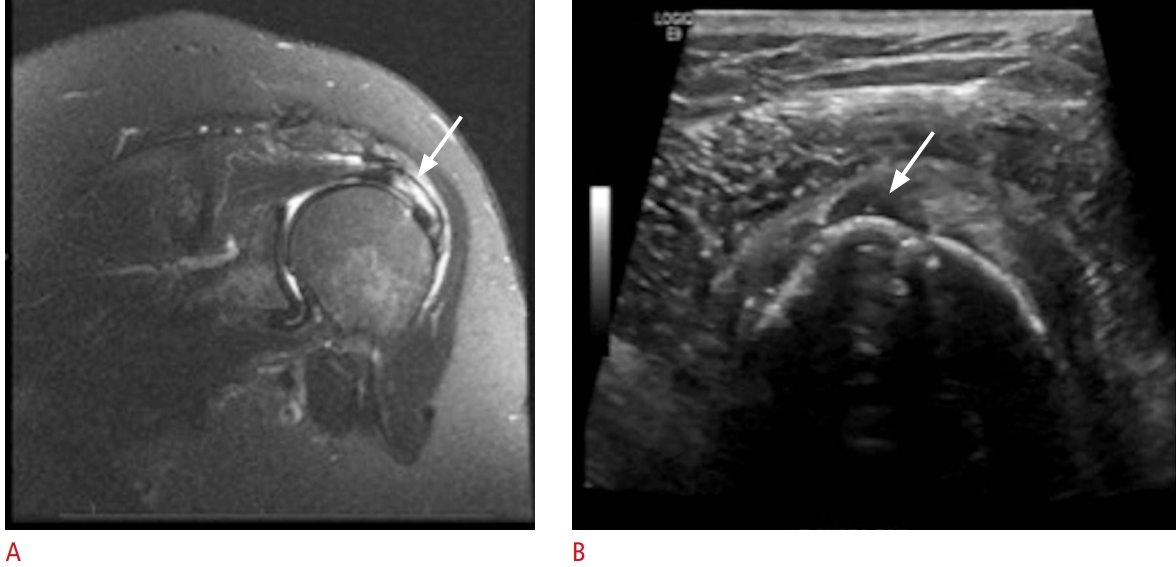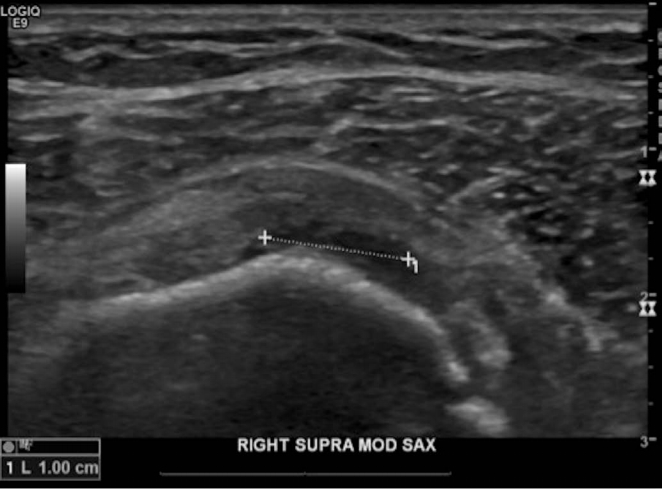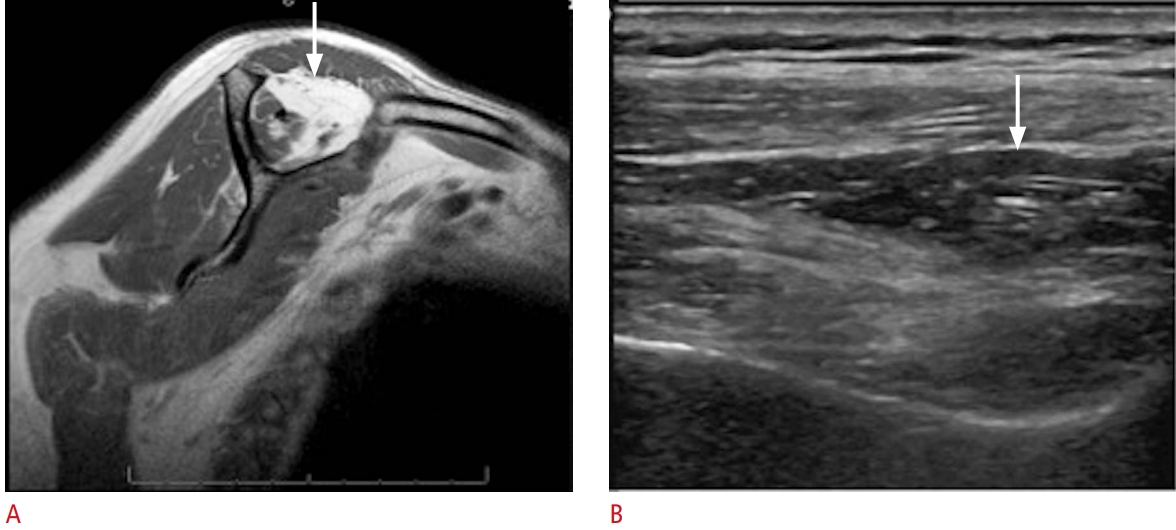Introduction
Rotator cuff tears (RCTs) are one of the most common causes of shoulder pain and account for nearly 4.5 million patient visits in the United States annually [1,2]. The incidence of RCTs increases with age, with approximately 25% of individuals over the age of 60 and 50% of individuals over 80 having experienced a full-thickness RCT [3]. Determining the integrity of the rotator cuff tendons is essential in deciding between surgical and non-surgical management [4]. In addition to a physical examination, imaging-most commonly, ultrasonography (US) or magnetic resonance imaging (MRI)-is usually necessary to diagnose an RCT [5].
Multiple studies have demonstrated that US and MRI have comparable accuracy in diagnosing RCTs before surgery, although the accuracy of US is more operator-dependent [6-11]. Although recent studies have found that experienced sonographers can provide accurate imaging, enabling the size and thickness of RCTs to be predicted, one may not always be readily available [12,13]. However, US is more accessible and cost-efficient than MRI. The efficiency, relatively low cost, and low risk of US make it a good initial method for detecting RCTs.
Although studies have suggested that US is an efficient tool for diagnosing full-thickness RCTs, controversy exists regarding the accuracy of US in detecting partial-thickness tears and other characteristics of RCTs [10,14-16]. The purpose of this article is to review the diagnostic accuracy of US for identifying RCTs, including assessments of the severity of the tear and ancillary findings such as fatty degeneration and tendon retraction.
Full-Thickness RCTs
Previous studies have demonstrated the capability of US to diagnose full-thickness RCTs. In 2008, Fotiadou et al. [17] evaluated the accuracy of US in detecting full-thickness RCTs in 96 patients with clinically suspected rotator cuff pathology. The authors found that in 57 patients with arthroscopically confirmed full-thickness RCTs, US was 98% accurate in identifying the tears [17]. Similarly, Moosmayer et al. [15] reported that US correctly identified 24 of 24 full-thickness RCTs, confirmed by intraoperative findings. The accuracy of US in diagnosing RCTs has also been found to be similar to that of MRI. In 2010, Rutten et al. [18] demonstrated US and MRI to be comparably accurate in diagnosing full-thickness RCTs (94% and 94%, respectively). Fig. 1 demonstrates a full-thickness RCT on both MRI and US in the same patient.
However, published results on the sensitivity of US in detecting full-thickness RCTs vary widely. Using arthroscopy as the standard, Cowling et al. [19] found US to have high sensitivity and specificity for detecting full-thickness RCTs (92.3% and 93.0%, respectively). In contrast, Paavolainen and Ahovuo [20] recorded an overall sensitivity of 74% and specificity of 95% of US in detecting 20 full-thickness RCTs. Furthermore, Martin-Hervas et al. [16] found US to be highly specific in in diagnosing full-thickness RCTs (100%), but not as sensitive (57.7%). Similarly, using 3.0-T MRI as the diagnostic standard, Yazigi et al. [21] found a 100% specificity and 46.2% sensitivity of US for full-thickness tears of the supraspinatus. These studies suggest that US has high specificity for diagnosing full-thickness RCTs. While US has high specificity and can be used to rule out an RCT if not present on US imaging, the exam is less sensitive and may not capture all tears, or the extent of the tear.
Partial-Thickness RCTs
The literature on the ability of US to accurately diagnose partial-thickness RCTs is heterogeneous. In 2008, Fotiadou et al. [17] evaluated the accuracy of US in detecting partial-thickness RCTs. They found that US was 87% accurate in identifying either bursal or articular partial-thickness tears, whereas MRI was 90% accurate [17]. Similar findings were presented by Rutten et al. [18], who found US to be 81% accurate and MRI to be 84% accurate for detecting partial-thickness tears. Moosmayer et al. [15] found US to be a poor tool when radiologists were blinded to clinical presentation. In their cohort of 14 partial-thickness tears, US only correctly identified one tear as partial-thickness [15]. Using arthroscopy as the gold standard, Teeffey et al. [11] prospectively studied 71 consecutive patients with shoulder pain. There were 6 diagnostic errors in 19 patients with partial-thickness tears. In two cases, the tears were missed. In the remaining four cases, US mistakenly diagnosed full-thickness tears [11]. Fig. 2 presents a representative image of a partial articular-sided RCT with intact bursal fibers.
The sensitivity and specificity of US for diagnosing partial-thickness RCTs has been found to be lower than for full-thickness RCTs. Cowling et al. [19] found that the sensitivity and specificity of US in detecting partial-thickness tears were 65.0% and 94.0%, respectively. Elmorsy et al. [22] retrospectively evaluated a cohort of 255 patients who underwent shoulder arthroscopy and compared preoperative MRI and US imaging findings to intraoperative findings. They determined that US was less sensitive than MRI for detecting partial-thickness RCTs, but not to a statistically significant extent (23% vs. 54.1%, respectively; P=0.333). Additionally, they found US to be more specific than MRI for identifying partial-thickness RCTs (90.1% vs. 72.6%, respectively; P<0.001), and therefore recommended US as the preferred diagnostic modality for RCTs at their institution [22].
Martin-Hervas et al. [16] determined US to have acceptable specificity of 67.9% for partial tears, but very low sensitivity (12.5%), and therefore advocated for the use of MRI in addition to US for diagnosing partial RCTs in patients who have clinical signs of shoulder pathology. MRI in conjunction with US increased the sensitivity of the test to 63.6% [16]. Similarly, Sipola et al. [8] advocated for the use of MRI to confirm negative US findings in patients with signs and symptoms of a RCT who have not experienced symptom relief after 3 months of conservative treatment. These studies suggest that US has relatively low sensitivity and specificity for diagnosing partial-thickness RCTs. As the sensitivity of US for partial-thickness RCTs is low, it is possible to miss the diagnosis if the exam is used in isolation. The addition of MRI imaging to US in patients who are suspected of having partial-thickness tears increases the chances of identifying the tear. Based on this literature review, US is an appropriate method for the initial diagnostic workup of a partial-thickness tear, but MRI should be strongly considered in the event of negative US findings with continued symptoms despite conservative management or an examination that is discordant with imaging.
Tear Size, Tendon Retraction, and Fatty Infiltration
The literature shows various results regarding the ability of US, compared with other modalities, to assess characteristics of RCTs such as tear size, tendon retraction, and fatty infiltration. Some studies have shown that shoulder US was comparable to MRI for determining the size of RCTs. In an evaluation of 42 shoulders with office-based US, Iannotti et al. [23] found US to have an 86% sensitivity for determining the anteroposterior dimensions of the RCTs, compared to 93% sensitivity with MRI. When evaluating tear retraction, US was found to have an 83% sensitivity while MRI was 88% sensitive [23]. In a study by Teefey et al. [9], US correctly predicted the degree of tendon retraction in 73% of full-thickness RCTs, while correctly predicting tear width in 87% of patients with full-thickness tears. That study also found that the length of partial-thickness tears was correctly identified in 11 of 13 US examinations (85%), and that most of the errors in tear retraction and width occurred in cases of massive or large RCTs [9].
The accuracy of US compared to arthroscopic findings in detecting RCT size has also been evaluated. Al-Shawi et al. [24] divided full-thickness RCTs into small (<1 cm), moderate (1 to 3 cm), and large/massive (>3 cm). The study found that the estimation of tear size was more accurate for large and massive tears (96.5%) than for moderate (88.8%) and small (91.6%) tears [24]. On the contrary, another group of researchers compared the utility of MRI and US for characterizing RCTs in 114 patients [25]. That study found that MRI and US were comparable in terms of measuring tear width and retraction until the tear size approached 2 cm; for tear sizes larger than 2 cm, US underestimated tear width and retraction.
Additionally, that study found that the agreement between MRI and US for tear width and retraction was moderate, whereas their agreement for muscle atrophy and fatty infiltration was only slight or fair. Wall et al. [26] evaluated the diagnostic performance and reliability of US for determining fatty degeneration, using MRI as the standard. They found US to be 92.5% accurate in regard to the supraspinatus and infraspinatus and 87.5% accurate for the teres minor. The level of agreement between US and MRI for the supraspinatus and infraspinatus was relatively high (kappa=0.76 and kappa=0.77, respectively), but lower for the teres minor (kappa=0.47) [22]. Both MRI and US imaging of a single patient with fatty infiltration of the supraspinatus muscle are shown in Fig. 3. These studies suggest that although US may be adequate for identifying the presence of an RCT, the accuracy of US for categorizing characteristics of RCTs, including tear width, retraction, fatty infiltration, and muscle atrophy, can vary based on tear size.
Recurrent Tears
The diagnosis of recurrent RCTs after repair can be challenging. MRI has been shown to be relatively accurate in identifying full-thickness re-tears after surgery [27]. However, the implants used during surgical repair can cause artifacts on MRI, which may make identifying recurrent partial-thickness tears more difficult [27,28]. Using revision arthroscopy as the gold standard for diagnosis, Gilat et al. [29] found US to have a sensitivity of 80.8% and specificity of 100% in the diagnosis of rotator cuff re-tears. The sensitivity increased to 94.7% and 100% specificity when partial rotator cuff re-tears were omitted from the analysis [29]. Prickett et al. [30] evaluated 34 patients who underwent rotator cuff repair, and found ultrasound to be 91% sensitive and 86% specific, with an accuracy of 89%, in determining rotator cuff integrity postoperatively. These studies demonstrated promising results when US was used to identify a re-tear of the rotator cuff after surgery. Full thickness retears have been shown to be easier to identify than partial thickness re-tears using US.
Transducer Frequency
Technical improvements such as 7.5-14 MHz linear array broad-bandwidth transducers and better penetration of the US beam, as well as increased experience, can significantly improve US results and reliability [31]. By using a high frequency, transducers have greatly enhanced the efficacy of US. Conducting US with high-frequency linear array transducers and high-resolution equipment has greatly increased its efficacy [32].
In a 2011 systematic review, Smith et al. [10] found superior diagnostic accuracy using 7.5 MHz compared to 10 MHz for detecting partial RCTs. The pooled sensitivity for the 7.5 MHz transducer was 90% (95% confidence interval [CI], 87% to 93%), whereas the 10 MHz transducer demonstrated a pooled sensitivity of 66% (95% CI, 44% to 76%) [10].
While transducer frequency has been shown to effect the quality and accuracy of imaging, US of the rotator cuff is highly operator-dependent. Small errors in transducer orientation and angulation may easily obscure small areas of normal variation within and around the cuff and give rise to false-positive and false-negative results [32]. A study evaluating surgeon-sonographer interactions found that error can come arise from three sources: the US operator obtaining the images, the interpretation of the images, and the quality of the equipment itself [33]. It is important to recognize these potential pitfalls when using US as a primary imaging modality.
Ultrasound Technicians
The experience of the sonographer and reviewer is a key factor in inter- and intra-observer reliability [10,12,13,34]. There is a steep learning curve when performing and interpreting US of the rotator cuff, with the number of US exams and frequency of US use directly correlating with accuracy [35]. Those learning to interpret the rotator cuff using US should follow a curriculum such as that recently updated by the American Medical Society for Sports Medicine [23]. Interestingly, surgeon-sonographer interaction has been shown to improve the diagnostic utility of US [33]. Iannotti et al. [23] found that US was 52% accurate for blinded interpretation, compared to 80% when US was combined with clinical information.
The profession of the operator has also been shown to influence the sensitivity and specificity of US in detecting RCTs. A systematic review and meta-analysis of 62 studies found that the diagnostic accuracy of US was greatest when performed by a musculoskeletal radiologist, followed by orthopedic surgeons. General radiologists without a particular interest in musculoskeletal radiology and sonographers had lower levels of accuracy [10].
Summary
US is an effective diagnostic tool for evaluating rotator cuff tendon pathology. As shown in the literature, US is accurate for detecting full-thickness RCTs. However, in patients with negative US findings for a full-thickness RCT but high clinical suspicion, MRI should be utilized to further evaluate the integrity of the rotator cuff. US is less accurate for diagnosing partial-thickness RCTs. In the evaluation of a patient with a suspected partial-thickness RCT who has persistent symptoms despite conservative treatment, an MRI scan should be obtained to identify the source of symptoms.
For evaluating the characteristics of RCTs, US may be less accurate than MRI. Although US has shown good accuracy in determining whether a tear is present, MRI may be more suitable for determining tear size, tendon retraction, muscle atrophy, and the degree of fatty infiltration. In evaluating patients with recurrent shoulder pain after a rotator cuff repair, US has been found to be an accurate tool in diagnosing re-tears, while limiting interference from orthopedic hardware.
US equipment and operator experience have also been identified as factors that affect the accuracy of US in identifying RCTs. Generally, it is recommended that a 7.5-MHz transducer should be used and that a musculoskeletal radiologist should perform and interpret the findings of the study. Communication of clinical findings between the surgeon and radiologist has been shown to improve the accuracy of US for evaluating the rotator cuff.



 Print
Print facebook
facebook twitter
twitter Linkedin
Linkedin google+
google+



 Download Citation
Download Citation PDF Links
PDF Links PubReader
PubReader ePub Link
ePub Link Full text via DOI
Full text via DOI Full text via PMC
Full text via PMC




